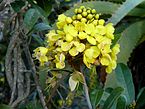bio.wikisort.org - Plant
Acridocarpus natalitius, the moth fruit, is a species of plant in the Malpighiaceae family. It is found in south-eastern Africa, where it ranges from Pondoland to Limpopo in South Africa, and eastwards to Eswatini and Mozambique. It is critically endangered in eastern Zimbabwe.
| Acridocarpus natalitius | |
|---|---|
 | |
| Acridocapus natalitius at Kew Gardens | |
| Scientific classification | |
| Kingdom: | Plantae |
| Clade: | Tracheophytes |
| Clade: | Angiosperms |
| Clade: | Eudicots |
| Clade: | Rosids |
| Order: | Malpighiales |
| Family: | Malpighiaceae |
| Genus: | Acridocarpus |
| Species: | A. natalitius |
| Binomial name | |
| Acridocarpus natalitius | |
It is the southernmost species of its genus, and occurs in subtropical dry forests to subtropical dry shrubland. The flowers are visited by ants and bees. The samara fruit appear in summer, each with two to three veined wings, which remind of a moth with opened wings. It is a host plant for skipper butterflies.
References
Wikimedia Commons has media related to Acridocarpus natalitius.
Текст в блоке "Читать" взят с сайта "Википедия" и доступен по лицензии Creative Commons Attribution-ShareAlike; в отдельных случаях могут действовать дополнительные условия.
Другой контент может иметь иную лицензию. Перед использованием материалов сайта WikiSort.org внимательно изучите правила лицензирования конкретных элементов наполнения сайта.
Другой контент может иметь иную лицензию. Перед использованием материалов сайта WikiSort.org внимательно изучите правила лицензирования конкретных элементов наполнения сайта.
2019-2025
WikiSort.org - проект по пересортировке и дополнению контента Википедии
WikiSort.org - проект по пересортировке и дополнению контента Википедии


